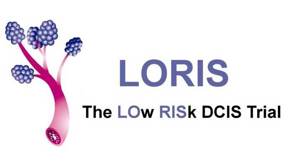LORIS
Overview
LORIS trial is a multi-centre, randomised (1:1), controlled phase III trial of Surgery versus Active Monitoring in patients with low risk ductal carcinoma in situ (DCIS), which incorporated a 2 year internal Feasibility Study.
The introduction of mammographic breast screening in the United Kingdom (UK) has resulted in a dramatic increase in the diagnosis of Ductal Carcinoma in situ (DCIS). Screen-detected DCIS now accounts for 20% of ‘cancers’ identified through breast screening. At present, all DCIS is treated by surgery because it is not known which cases would not progress in the woman’s lifetime to a life threatening invasive tumour. The inevitable consequence of overdiagnosis is ‘overtreatment’.
The experimental arm of the LORIS trial is Active Monitoring alone, to answer the trial question of whether low risk DCIS is being overtreated, with healthy women undergoing unnecessary cancer treatment.
The results of the LORIS trial will enable women to make a better-informed choice about their options if diagnosed with low risk DCIS.
Objectives
Primary objective
To assess whether Active Monitoring is non-inferior to Surgery, in terms of ipsilateral invasive breast cancer free survival time
Primary Outcome Measure
- Ipsilateral invasive breast cancer free survival time
Secondary Outcome Measure
- Time to development of ipsilateral invasive breast cancer
- Time to development of any invasive breast cancer
- Time to development of contralateral invasive breast cancer
- Overall survival
- Time to mastectomy
- Time to surgery
- Quality of Life (QoL)
- Quality-Adjusted Life Years
- Costs and cost-utility
Inclusion criteria
- Female, aged ≥ 46 years
- Screen-detected or incidental microcalcification
- Histologically confirmed diagnosis of non-high grade DCIS confirmed by local pathologist (for both breasts if bilateral disease) by:
- Small volume core biopsy and Vacuum Assisted Core Biopsy (VACB) Or
- Vacuum Assisted Core Biopsy (VACB) alone as first line diagnostic approach Or
- Small volume biopsy or VACB plus open diagnostic surgical biopsy (without clear margins) Or
- Open diagnostic surgical biopsy (without clear margins)(in accordance with the current NHSBSP Guidelines for Pathology Reporting in Breast Cancer Screening)
- DCIS diagnosed ≤90 days before registration
- Bilateral DCIS is permitted if non-high grade DCIS is confirmed in both breasts at the time of mammogram and diagnostic biopsy
- Able to give informed consent and comply with the trial schedule and completion of Patient Reported Outcome questionnaires
- Patient fit and willing to undergo surgery
- Written Informed Consent obtained
Exclusion criteria
- Previous or current diagnosis of invasive breast cancer or previous ipsilateral DCIS (previous surgically treated contralateral DCIS is permitted)
- A mass lesion clinically on imaging at the site of the microcalcification which has not been proven on biopsy to be a specific benign lesion
- Surgical procedure with curative intent (even if clear margins have not been achieved)
- Unequivocal comedo necrosis observed
- Any serious and/or unstable pre-existing condition that would prevent compliance with the trial or the consent process
- Recent onset ipsilateral blood-stained nipple discharge without benign explanation
- High risk group for developing breast cancer (as defined in current NICE guidelines for familial breast cancer (42), or due to prior exposure to mantle field radiotherapy)
Planned sample size
N= 932 women
Timeline
July 2014 - March 2020
Website
Trial website





